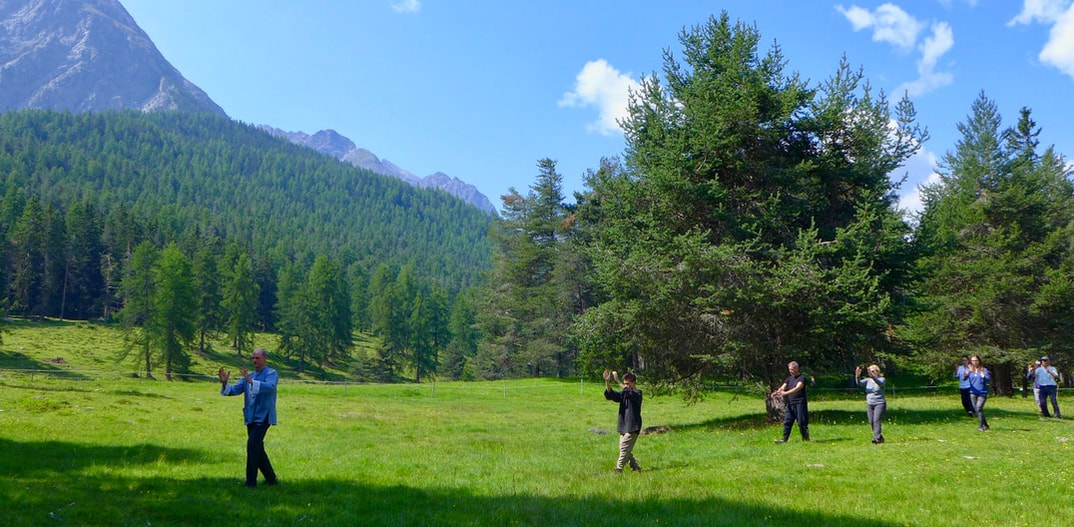"Big watermelon, cut half. Serve left, serve right." - This is what I remember of Tai Ji Quan as a child growing up in Malaysia. We were at my uncle's and aunt's house for Chinese New Year celebrations and they wanted to share that new video that they were following along with to learn Tai Ji Quan. As I listened and watched, I thought then, "old people's exercise."
As I got to the US, I was in a modern contemporary dance class in university. The teacher, a former professional dancer with the Martha Graham Dance Company in her mid-30s, started to introduce some movements from Tai Ji Quan in our dance class. I thought, "Oh, my...big watermelon is back. Maybe there is something to this movement form, maybe I need to be more open to it, maybe it isn't just for old people." When I was injured from dancing later, I decided to take a Tai Ji Quan course taught by a physical education professor from China, who was doing a study on Tai Ji Quan and balance in the elderly at my university. I thought then that the movements of Tai Ji Quan were actually quite circular and inward-focused; in contrast to ballet, which were more focused on creating long lines that extend outward.
When I finally got to Chinese Medicine school, I knew that I wanted to study Qi Gong to aid in my energetic studies. I looked for a teacher near to where I lived, I found Shi Fu Donald and Cheryl Lynne Rubbo; they taught Qi Gong, Tai Ji Quan and Shao Lin Quan Gong Fu. After Qi Gong class, Tai Ji Quan would often begin and I saw people of all ages, children-teenagers from 10 years old onward, and adults from 20 to 70. My teachers were in their 40s. They were doing robust exercises, not just round watermelon-serving movements ;-) but low, deep stances that required strength and flexibility to perform. They were jumping, kicking, punching and blocking, sometimes in slow motion but also in normal or fast speed. It was then that I realized that Tai Ji Quan is a martial art; that some people actually practice this form of movement in order to fight and defend themselves from attack. My Shi Fu had the ability to apply their skills in combat but they chose to use them for health purposes; to train the body-mind to find healing and balance in life. I was encouraged by my Shi Fu to join Tai Ji Quan class too and later on Shao Lin Quan.
It took me a while to un-train my body, from the tension-filled holding and overextending style, which is normal in ballet, to a relaxed, easy sustaining of a posture or in performance of a movement. What is asked for in the practice of Tai Ji Quan is holding poses without muscular tension and moving in a flowing manner with little effort. This is the concept of Sōng 鬆 ; to let go of muscular tension and, enable Qi to flow as well as sustain postures and movement. Every time I thought I was getting it, Shi Fu Donald would tell me to relax and let go of the tension I was holding. Another focus of Tai Ji Quan that I find so vital and challenging is the movement that comes from the centre, the Dān Tían 丹田 . I had often heard in ballet classes to "move from my centre," but nobody could ever explain or showed me what that meant. This I learned vey quickly with my Tai Ji Quan teacher, as every time I would perform a movement he would come over to show me the martial application of it and my stance would crumble, if I was not moving or connected to my centre. Another aspect that I developed from the practice was patience and humility. Since I began learning organized movement from the age of 5, learning movement comes quick to me, but my Shi Fu would introduce to me 1 posture of the 64 from the Guang Ping Yang Style Tai Ji Quan form over a period of weeks, sometimes months. So, I learned to be patient and persevere in my repetitive practice of the same movements, sometimes at very slow speeds and sometimes on my own, as the other more advanced students continued on with the 64 movements.
As I look back on my first contact with Tai Ji Quan as a young person in Malaysia and what I later experienced practicing it, I realized that I was young and arrogant; too busy indulging in my youthful strength and sneering at those I imagined to be inferior to me. Making a movement like a big watermelon may sound silly, but it is an easy way to remember how to make the circular movement with the arms - a mnemonic. Like many things in Tai Ji Quan, or for that matter Chinese Medicine, it may seem simple but is effective and often times profound. As I have once mentioned in a previous post, there is a Chinese saying, "When you are ill, get Acupuncture/ Moxibustion, Tui Na and take Herbal Medicine. If you want to stay healthy, sleep enough and eat healthy. If you want to build strength, practice Tai Ji Quan/ Qi Gong." This is what I have observed for myself, Tai Ji Quan has helped me to develop not only physical strength in my body but also mental resilience in the face of challenging situations. Most importantly the patience and humility to approach life and the people I encounter.
Photo by Elaine


 RSS Feed
RSS Feed